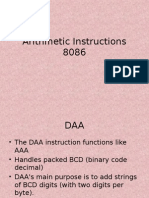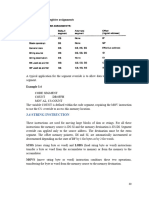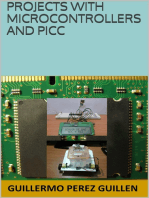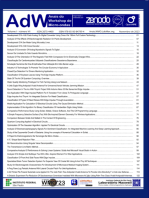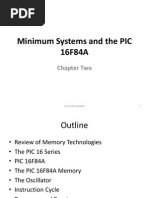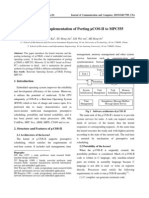0 ratings0% found this document useful (0 votes)
109 viewsLogic Control
The document discusses logic and control instructions in assembly language. It covers different types of control transfer operations like unconditional jumps, conditional jumps, and calls. It also discusses logical and bitwise operations, compare operations, flags register, and examples of instructions like JMP, LOOP, CMP, and their usage. Control transfer operations allow altering execution order, conditional jumps transfer control based on flag conditions, and logical operations perform operations like AND, OR, XOR on operands.
Uploaded by
joeytorioCopyright
© © All Rights Reserved
Available Formats
Download as PDF, TXT or read online on Scribd
0 ratings0% found this document useful (0 votes)
109 viewsLogic Control
The document discusses logic and control instructions in assembly language. It covers different types of control transfer operations like unconditional jumps, conditional jumps, and calls. It also discusses logical and bitwise operations, compare operations, flags register, and examples of instructions like JMP, LOOP, CMP, and their usage. Control transfer operations allow altering execution order, conditional jumps transfer control based on flag conditions, and logical operations perform operations like AND, OR, XOR on operands.
Uploaded by
joeytorioCopyright
© © All Rights Reserved
Available Formats
Download as PDF, TXT or read online on Scribd
You are on page 1/ 75
CT215 Comp. Org.
& Assembly Logic and Control Instructions 1
Logic and Control
Instructions
CT215 Comp. Org. & Assembly Logic and Control Instructions 2
Objectives
Control transfer operations
Logical comparisons
Logical and bit-wise operations
Program organization
CT215 Comp. Org. & Assembly Logic and Control Instructions 3
Control Transfer Operations
A transfer of control is a way of altering the
order in which statements are executed.
Unconditional transfer -- branches to a new
location in all cases -- JMP, LOOP, CALL
Conditional transfer -- branches if a certain
condition is true. The CPU interprets true/false
conditions based on the content of the CX and
Flags registers -- JZ, JE, JNZ, JNE, JC, JNC
CT215 Comp. Org. & Assembly Logic and Control Instructions 4
Compare Operations
CMP
TEST
CT215 Comp. Org. & Assembly Logic and Control Instructions 5
Logical and Bit-wise Operations
Logical operations --
AND, OR, NOT, XOR
Shift and rotate --
SAR/SHR
SAL/SHL
RCR/ROR
RCL/ROL
CT215 Comp. Org. & Assembly Logic and Control Instructions 6
JMP Instruction
JMP Label ;in current
segment
JMP NEAR PTR Label;near: in current
segment
JMP SHORT Label ;in current seg
JMP FAR PTR Label ;to different seg
[label:] JMP [option] destination label
CT215 Comp. Org. & Assembly Logic and Control Instructions 7
Example
0100 B4 02 Start: MOV AH,2
0102 B2 41 MOV DL,A
0104 CD 21 INT 21H
0106 EB F8 JMP Start
0108 ...
EB:short jump
E9:near jump
CT215 Comp. Org. & Assembly Logic and Control Instructions 8
Instructions Addressing
Short address --
limited to a distance of -128 to 127 bytes of
instructions, 1 byte offset
Near address --
limited to a distance of -32,768 to 32,767 bytes of
instructions within the same segment, 1-2 words
offset
Far address --
over 32K or another segment
CT215 Comp. Org. & Assembly Logic and Control Instructions 9
Distance Rules
Short Near Far
-128 to 127 -32K to 32K Over 32K
Instruction Same segment Same segment Another segment
JMP yes yes yes
Jcond yes yes (386+) no
LOOP yes no no
CALL n/a yes yes
CT215 Comp. Org. & Assembly Logic and Control Instructions 10
Example
Label1: JMP SHORT Label2
.
.
.
Label2 JMP Label1
CT215 Comp. Org. & Assembly Logic and Control Instructions 11
PAGE 60, 123
TITLE JUMP program
.MODEL SMALL
.CODE
ORG 100H
;-----------------------------------------
Main PROC NEAR
MOV AX,01 ;
MOV BX,01 ;
MOV CX,01 ;
A20: ADD AX,01 ;Add 01 to AX
ADD BX,AX ;Add AX to BX
SHL CX,1 ;Double CX
JMP A20 ;Repeat at label A20
Main ENDP ;end of procedure
END ;end of program
CT215 Comp. Org. & Assembly Logic and Control Instructions 12
PAGE 60, 123
TITLE JUMP program
.MODEL SMALL
0000 .CODE
ORG 100H
;-----------------------------------------
0100 Main PROC NEAR
0100 B8 0001 MOV AX,01 ;
0103 83 C3 01 MOV BX,01 ;
0106 B9 0001 MOV CX,01 ;
0109 83 C0 01 A20: ADD AX,01 ;Add 01 to AX
010C 03 D8 ADD BX,AX ;Add AX to BX
010E D1 E1 SHL CX,1 ;Double CX
0110 EB F7 JMP A20 ;Repeat at label A20
0112 Main ENDP ;end of procedure
END ;end of program
CT215 Comp. Org. & Assembly Logic and Control Instructions 13
LOOP Instruction
repeat a block of statements with a
specific number of times
CX register is automatically used as a
counter and decremented each time the
loop repeats
does not change flag
destination must be (short) -128 to 127
bytes from the current location
CT215 Comp. Org. & Assembly Logic and Control Instructions 14
LOOP Instruction
The LOOP instruction subtract 1 from
CX register
if CX is not zero, control transfer to
destination
LOOPE/LOOPZ, LOOPNE/LOOPNZ
LOOPW, LOOPD (386) uses the 32-bit
ECX register
[label:] LOOP destination label
CT215 Comp. Org. & Assembly Logic and Control Instructions 15
Example
MOV CX,5 ;initialized CX
Start:
.
.
.
LOOP Start;jump to Start
CT215 Comp. Org. & Assembly Logic and Control Instructions 16
Flag Register
Some instructions, when executed, change
the status of the flags
Different instructions effect different flags
Some instructions effect more than one flag,
and some do not effect any flags
There are instructions that test the flags and
base their actions on the status of those
flags, e.g., Conditional jump instructions
CT215 Comp. Org. & Assembly Logic and Control Instructions 17
Flags Register
O = Overfl ow -- indicate overflow of the left most bit following arithmetic
D = Di rect i on -- determine left or right direction for moving or comparing data
I = Interrupt -- indicate that all interrupts to be processed or ignored
T = Trap -- permit operation of the processor in single-step-mode
S = Si gn -- indicate the resulting sign of an arithmetic operation, 0 (negative), 1
(positive)
Z = Zero -- indicate the resulting sign of an arithmetic or comparison operation,
0 (nonzero), 1 (zero) result
A = Auxiliary carry -- contain a carry out of bit 3 on 8-bit data
P = Parity -- indicate even or odd parity of a low-order 8-bit data operation
C = Carry -- contain the leftmost bit
x = undefi ned
CT215 Comp. Org. & Assembly Logic and Control Instructions 18
Flags Registers
15 14 13 12 11 10 9 8 7 6 5 4 3 2 1 0
x x x x O D I T S Z x A x P x C
CT215 Comp. Org. & Assembly Logic and Control Instructions 19
CF -- Carry Flag
Is set when the result of an unsigned
arithmetic operation is too large to fit
into the destination, or shift and rotate
operations
Example: AL = FFH
ADD AL,01H
will set CF = 1, but INC AL will not set CF.
JC and JNC use this flag
CT215 Comp. Org. & Assembly Logic and Control Instructions 20
Example
Suppose AH = 00H, AL = FFH
. . . ;AX = 0000 0000 1111 1111
ADD AX,1;AX = 0000 0001 0000 0000
CF is set to 0
The carry flag contains the borrow after
a subtraction.
Example: AL = 00H
SUB AL,1;AL = 1111 1111 and CF = 1
CT215 Comp. Org. & Assembly Logic and Control Instructions 21
CF -- Carry Flag
Several other instructions effect the carry
flag: CMP, TEST, SHL, SHR, etc.
Two instructions explicitly change the carry
flag:
CLC: clear CF to 0
STC: set CF to 1
CT215 Comp. Org. & Assembly Logic and Control Instructions 22
AF -- Auxiliary Flag
Is set when an operation causes a carry from
bit 3 to bit 4 (or borrow from bit 4 to bit 3)
of operand.
Example: AL = 9BH = 1001 1011
ADD AL,7 ; AL = A2H = 1010 0010
CF = 0
AF = 1
CT215 Comp. Org. & Assembly Logic and Control Instructions 23
ZF -- Zero Flag
Effected by arithmetic and logic operations
and the CMP operation
Set to 1 if result of operation is zero;
otherwise it is reset to 0.
Used by conditional jumps such as JZ, JE,
JNZ and JNE
CT215 Comp. Org. & Assembly Logic and Control Instructions 24
SF -- Sign Flag
Set according to the sign of the result of an
arithmetic operation.
If result of last operation is negative, then
SF is set to 1; otherwise, SF is set to 0
Use it only when doing signed arithmetic.
Used by conditional jumps such as JS, JL,
JNS, JGE
CT215 Comp. Org. & Assembly Logic and Control Instructions 25
OF -- Overflow Flag
Effected when signed numbers are added or
subtracted.
An overflow indicates that the result does
not fit in the destination operand.
Example: ADD AL, BL
If result is not in (-128, 127), an overflow occurs.
Use Overflow with signed arithmetic.
JO, JNO among others
CT215 Comp. Org. & Assembly Logic and Control Instructions 26
Other Flags
PF (Parity Flag)
TF (Trap Flag)
IF (Interrupt Flag)
CT215 Comp. Org. & Assembly Logic and Control Instructions 27
Example
Before: DL = 12H
ADD DL, 33H
After: DL = 45H
CF= 0 , ZF= 0, SF = 0, OF = 0
CT215 Comp. Org. & Assembly Logic and Control Instructions 28
Example
Before: DL = F3H
ADD DL,F6H
After: DL = E9H
CF = 1, ZF = 0, SF=1, OF=0
Two interpretations: Signed or Unsigned
Unsigned: Ignore SF and OF
Signed: Ignore CF
CT215 Comp. Org. & Assembly Logic and Control Instructions 29
Unsigned Operation
Hex Binary Interpretation
(Unsigned) Decimal
F3H 1111 0011 243
F6H 1111 0110 246
1 E9H 11110 1001 489
Result: a sum of E9H and a carry out of 1, set
CF=1
CT215 Comp. Org. & Assembly Logic and Control Instructions 30
Unsigned Operation
Hex Binary Interpretation
(2s complement) Decimal
F3H 1111 0011 -13
F6H 1111 0110 -10
1 E9H 11110 1001 -23
In 2s complement addition, carry is discarded
result: DL = E9H which is interpreted as -23
SF = 1, CF = 0, OF = 0
CT215 Comp. Org. & Assembly Logic and Control Instructions 31
CMP Instruction
Compare two numeric data fields
Effects the flags: ZF, SF, CF, AF, OF, PF
Example:
CMP DX,10
JE P50
... ;continue if not equal
P50: ... ;Jump point if DX is zero
JE tests only the ZF flag
[label:] CMP reg/mem,reg/mem/imd
CT215 Comp. Org. & Assembly Logic and Control Instructions 32
CMP Instruction
CMP subtracts the second operand from the
first and sets the flags accordingly
if result is equal to 0 set ZF to 1
=> two operands are equal
if result is positive set SF to 0 or CF to 0
=> first operand is greater than second operand
if result is negative set SF to 1 or CF to 0
=> first operand is less than second operand
CT215 Comp. Org. & Assembly Logic and Control Instructions 33
CMP Unsigned Operands
CMP Results CF ZF
Destination < Source 1 0
Destination = Source 0 1
Destination > Source 0 0
CT215 Comp. Org. & Assembly Logic and Control Instructions 34
CMP Signed Operands
CMP Results ZF SF, OF
Destination < Source ? SF <> OF
Destination = Source 1 ?
Destination > Source 0 or SF = OF
CT215 Comp. Org. & Assembly Logic and Control Instructions 35
Conditional Jump Instructions
Transfer control depending on status of the
flags register
test one or more of the following flag bits:
SF ZF CF PF OF
If the condition under test is true, then
branch to Label; otherwise, the next
sequential instruction (immediately
following the jump) is executed
[label:] Jcond Short address
CT215 Comp. Org. & Assembly Logic and Control Instructions 36
Conditional Jump Instructions
A20:
...
DEC CX ;decrement CX
JNZ A20;Jump if ZF = 0
...
CT215 Comp. Org. & Assembly Logic and Control Instructions 37
Signed and Unsigned Data
Example: CX=11000110, DX=00010110
MOV AX, 0
CMP CX, DX
JE P50 ;jump if ZF = 1
MOV AX, 1
P50: ...
What is the contents of AX?
CT215 Comp. Org. & Assembly Logic and Control Instructions 38
Jump for Unsigned Data
Using Above and Below
JE/JZ Jump if equal/jump if zero
JNE/JNZ Jump if not equal
JA Jump if above
JAE Jump if above or equal
JB Jump if below
JBE Jump if below or equal
Test the ZF and/or the CF flag bits.
CT215 Comp. Org. & Assembly Logic and Control Instructions 39
Jump for Signed Data
Using greater and less
JE/JZ ZF
JNE/JNZ ZF
JG jump if greater than (OF, SF)
JGE jump if greater or equal (OF, SF, ZF)
JL jump if less than (OF, SF)
JLE jump if less than or equal (OF, SF, ZF)
Test the ZF, SF and/or OF flag bits.
CT215 Comp. Org. & Assembly Logic and Control Instructions 40
Arithmetic Test
JCXZ jump if CX is zero
JC, JNC CF
JO, JNO OF
JP/JPE, JNP/JPO PF
JS, JNS SF
CT215 Comp. Org. & Assembly Logic and Control Instructions 41
Jumps Based on General
Comparisons
Mnemonic ZF CF PF CX
JZ 1
JE 1
JNZ 0
JNE 0
JC 1
JNC 0
JCXZ 0
JP 1
JNP 0
CT215 Comp. Org. & Assembly Logic and Control Instructions 42
Mnemonic ZF CF
JA 0 0
JNBE 0 0
JAE 0
JNB 0
JB 1
JNAE 1
JBE 1 or 1
JNA 1 or 1
Jumps Based on Unsigned
Comparisons
CT215 Comp. Org. & Assembly Logic and Control Instructions 43
Jumps Based on Signed
Comparisons
Mnemonic SF
JG 0 0
JNLE 0 0
JGE =OF
JNL =OF
JL
OF
JNGE
OF
JLE 1
or OF
JNG 1
or OF
JS 1
JNS 0
CT215 Comp. Org. & Assembly Logic and Control Instructions 44
Logical and Bit-wise Operations
Logical operations --
AND, OR, NOT, XOR
Shift and rotate --
SAR/SHR
SAL/SHL
RCR/ROR
RCL/ROL
CT215 Comp. Org. & Assembly Logic and Control Instructions 45
Logical Operations
AND
OR
XOR
NOT
They effect the ZF, SF and PF
[label:] operation reg/mem,reg/mem/imm
[label:] NOT reg/mem
CT215 Comp. Org. & Assembly Logic and Control Instructions 46
Examples
AND OR XOR TEST
Operand 1: 0101 0101 0101 0101
Operand 2: 0011 0011 0011 0011
--------------------
Rslt in Operand 1:0001 0111 0110 0101
Result: 0001
CT215 Comp. Org. & Assembly Logic and Control Instructions 47
OR Operation
May be used to test if a register is zero
OR DX,DX ;set ZF and SF
JZ ...
May be used to test the sign of a register
OR DX,DX
JS ...
Better use the CMP instruction for the
above
CT215 Comp. Org. & Assembly Logic and Control Instructions 48
AND Operation
May be used to test for a specific bit
MOV BL,00001000
AND BL,AL ;The result is equal
to 4th bit of AL
JZ ...
Another way
AND AL, 00001000
JZ ...
CT215 Comp. Org. & Assembly Logic and Control Instructions 49
AND Operation
May be used to Clear a register
AND BL,0H
May be used to mask some bits of a
register
AND BL,0FH ;zeros left 4 bits
AND BL,11000011B;Zeros the middle 4
bits
AND BL,11111101 ;Zeros the second bit
CT215 Comp. Org. & Assembly Logic and Control Instructions 50
TEST Operation
Performs the same function as the AND but
does not modify the destination register
TEST AL,00001000;is the 4th bit of
JZ ... ;AL 0 ?
TEST BL,00000001;Does BL contain an
JNZ ... ;odd value ?
TEST CL,11110000;Are any of the 4
leftmost
JNZ ... ; bits in CL nonzero?
CT215 Comp. Org. & Assembly Logic and Control Instructions 51
Shift Instructions
Used to position or move numbers to the left or to
the right within a register or a memory location
They also perform simple arithmetic (multiply or
divide by 2
n
).
Shift up to 8 bits in a byte, 16 bits in a word, 32
bits in a double word (386 and later)
Shift Logically (unsigned) or arithmetically(signed
data).
CT215 Comp. Org. & Assembly Logic and Control Instructions 52
Shift Instructions
1st operand is data to be shifted.
2nd operand is the number of shifts
register: can be any register except segment
register
for 8086, immediate value must be 1.
Use CL if need to shift by more than one bit.
for later processors, immediate value can be any
positive integer up to 31.
[label:] shift register/memory,CL/immediate
CT215 Comp. Org. & Assembly Logic and Control Instructions 53
Shift Instructions
Shift right
SHR: Logical shift right
SAR: Arithmetic shift right
Shift left
SHL: Logical shift left
SAL: Arithmetic shift left
CT215 Comp. Org. & Assembly Logic and Control Instructions 54
Shift Right
0 C
SHR:
S C
SAR:
CT215 Comp. Org. & Assembly Logic and Control Instructions 55
Instruction Binary Decimal CF
MOV AL,10110011B 1011 0011 179 -
SHR AL,01 0101 1001 89 1
MOV CL,02
SHR AL,CL 0001 0110 22 0
(80286+)
SHR AL,02
SHR
CT215 Comp. Org. & Assembly Logic and Control Instructions 56
Instruction Binary Decimal CF
MOV AL,10110011B 1011 0011 -77 -
SAR AL,01 1101 1001 -39 1
MOV CL,02
SAR AL,CL 1111 0110 -10 0
(80286+)
SAR AL,02
SAR
CT215 Comp. Org. & Assembly Logic and Control Instructions 57
SHR and SAR
Right shifts are especially useful for halving
values: i.e. integer division by 2
Right shift by 2 bits => divide by 4
Right shift by 3 bits => divide by 8 etc.
SHR: for unsigned numbers
SAR: for Signed numbers
Much faster than the divide instruction.
Shifting by 1 bit, the remainder is in CF.
CT215 Comp. Org. & Assembly Logic and Control Instructions 58
Shift Left
C 0 SHL & SAL:
CT215 Comp. Org. & Assembly Logic and Control Instructions 59
Instruction Binary Decimal CF
MOV AL,00001101B 0000 1101 13 -
SHL AL,01 0001 1010 26 0
MOV CL,02
SHL AL,CL 0110 1000 104 0
(80286+)
SHL AL,02 1010 0000 160 1
SHL
CT215 Comp. Org. & Assembly Logic and Control Instructions 60
Instruction Binary Decimal CF
MOV AL,11110110B 1111 0110 -10 -
SAL AL,01 1110 1100 -20 1
MOV CL,02
SAL AL,CL 1011 0000 -80 1
(80286+)
SAL AL,02 1100 0000 -64 0
SAL
CT215 Comp. Org. & Assembly Logic and Control Instructions 61
SHL and SAL
SHL and SAL are identical
SHL for unsigned and SAL for signed
can be used to double numbers.
Each bit shift to the left , double the value
shifting left by 2 bits = multiply by 4 etc.
Note: if after a left shift CF=1
size of the register/memory location is not large
enough for the result.
CT215 Comp. Org. & Assembly Logic and Control Instructions 62
Example
A code segment that will multiply AX by 10
Assume the number N is the content of AX
SHL AX, 1 ; AX = 2*N
MOV BX, AX ; save in BX
SHL AX, 2 ; AX = 8*N
ADD AX, BX ; AX = 2*N+8*N
CT215 Comp. Org. & Assembly Logic and Control Instructions 63
Rotate Instructions
Rotate binary data in a memory location
or a register either from one end to the
other, or through the CF.
Used mostly to
inspect specific bits
shift numbers that are wider that register size (I.e.
wider that 16 bits in 8086/286).
CT215 Comp. Org. & Assembly Logic and Control Instructions 64
Rotate Instructions
Rotate Right
ROR
RCR
Rotate Left
ROL
RCL
[label:] rotate register/memory,CL/immediate
CT215 Comp. Org. & Assembly Logic and Control Instructions 65
Rotate Right
C
ROR:
C
RCR:
CT215 Comp. Org. & Assembly Logic and Control Instructions 66
Rotate Left
C
ROL:
C
RCL:
CT215 Comp. Org. & Assembly Logic and Control Instructions 67
Example
Instruction Binary CF
MOV BL,10110100B 1011 0100 -
ROR BL,01 0101 1010 0
MOV CL,02
ROR BL,CL 1001 0110 1
MOV BL,10110100B 1011 0100 1
RCR BL,01 1101 1010 0
MOV CL,02
RCR BL,CL 0011 0110 1
CT215 Comp. Org. & Assembly Logic and Control Instructions 68
Example
Rotate instructions are often used to shift wide
numbers to the left or right.
Example: Assume a 48-bit number is stored in registers
DX, BX, AX
write a code segment to shift number to the left by one
position:
SHL AX,1
RCL BX,1
RCL DX,1
CT215 Comp. Org. & Assembly Logic and Control Instructions 69
Procedures
Syntax
proc-name PROC [NEAR/FAR]
...
...
RET
ENDP
NEAR indicates that the procedure is to be
called from within current segment (default)
FAR indicates that the procedure is to be
called from other segments
CT215 Comp. Org. & Assembly Logic and Control Instructions 70
Calling Procedure
The CALL transfers control to the called procedure:
save the current IP in the stack
load the IP with the address of the called procedure
The RET instruction returns control to the calling
procedure.
Restores the IP with the saved address
In general, the RET instruction is the last instruction in
a procedure.
[label:] CALL Proc-name
[label:] RET [Pop-value]
CT215 Comp. Org. & Assembly Logic and Control Instructions 71
CALL Procedure -- NEAR
CALL to a NEAR procedure
push IP on top of the stack. The IP at the time of
call contains the offset of the next instruction (after
the CALL instruction)
Load the offset of the first instruction of the called
procedure into the IP register.
RETURN from a NEAR procedure
Pop the top of the stack into the IP register
Instruction Queue is also saved/restored on
CALL/RET
CT215 Comp. Org. & Assembly Logic and Control Instructions 72
CALL Procedure -- FAR
CALL to a FAR procedure
push CS registers on top of the stack.
Load the CS register with address of new segment.
Push IP on top of the stack.
Load IP register with offset of the called procedure
RETURN from a FAR procedure
Pop the top of the stack into the IP register
Pop the top of the stack into CS register
FAR procedure will be dealt with in
Chapter 23.
CT215 Comp. Org. & Assembly Logic and Control Instructions 73
.Model SMALL
OFFSET .Stack 64
.Data
.Code
0100 MAIN PROC FAR
0100 MOV DL, 'O'
0103 CALL DISP
0105 MOV DL, 'K'
0107 CALL DISP
MAIN ENDP
0109 DISP PROC NEAR
0109 MOV AH, 2
010B INT 21H
010D RET
DISP ENDP
END MAIN
CT215 Comp. Org. & Assembly Logic and Control Instructions 74
Effect of program execution on
stack
Initialization: . STACK size
Each procedure call requires at least one word on
stack to save current IP (for NEAR procedures)
CT215 Comp. Org. & Assembly Logic and Control Instructions 75
You might also like
- CEL-324 Computer Organization and Assembly Language LabNo ratings yetCEL-324 Computer Organization and Assembly Language Lab9 pages
- Chapter Four Control Structures 4.1. The CMP Instruction: Page 1 of 5No ratings yetChapter Four Control Structures 4.1. The CMP Instruction: Page 1 of 55 pages
- CEL-324 Computer Organization and Assembly Language LabNo ratings yetCEL-324 Computer Organization and Assembly Language Lab7 pages
- Lab 2 - Intel 8086 Microprocessor: Logical Instructions and Jump Commands in Assembly LanguageNo ratings yetLab 2 - Intel 8086 Microprocessor: Logical Instructions and Jump Commands in Assembly Language10 pages
- EL213 Computer Organization & Assembly Language Lab 08: Conditional ProcessingNo ratings yetEL213 Computer Organization & Assembly Language Lab 08: Conditional Processing14 pages
- Assembly Language Programming - CS401 Power Point Slides Lecture 02No ratings yetAssembly Language Programming - CS401 Power Point Slides Lecture 0215 pages
- Weeks 6 8088/8086 Microprocessor ProgrammingNo ratings yetWeeks 6 8088/8086 Microprocessor Programming45 pages
- Lab Manual # 06: The Carry Flag Indicates Whether or Not The Upper Half of The Product Contains Significant DigitsNo ratings yetLab Manual # 06: The Carry Flag Indicates Whether or Not The Upper Half of The Product Contains Significant Digits6 pages
- Microprocessor Systems and Interfacing (Eee342) : Dr. Omer Chughtai Assistant Professor, CUI, Wah Campus EmailNo ratings yetMicroprocessor Systems and Interfacing (Eee342) : Dr. Omer Chughtai Assistant Professor, CUI, Wah Campus Email68 pages
- Objective:: Computer Systems EngineeringNo ratings yetObjective:: Computer Systems Engineering8 pages
- x86 Instructions - Windows drivers _ Microsoft LearnNo ratings yetx86 Instructions - Windows drivers _ Microsoft Learn14 pages
- Unit II: Instruction Set and Addressing ModesNo ratings yetUnit II: Instruction Set and Addressing Modes53 pages
- CX Programer-Help-Instruction Sets - CP1H-CP1L SeriesNo ratings yetCX Programer-Help-Instruction Sets - CP1H-CP1L Series12 pages
- CX Programer-Help-Instruction Sets - CP1E SeriesNo ratings yetCX Programer-Help-Instruction Sets - CP1E Series8 pages
- CX Programer-Help-Instruction Sets - C-SeriesNo ratings yetCX Programer-Help-Instruction Sets - C-Series8 pages
- Segment Registers: Type of Memory Reference Default Segment Alternate Segment Offset (Logical Address)No ratings yetSegment Registers: Type of Memory Reference Default Segment Alternate Segment Offset (Logical Address)80 pages
- Microprocessor System & Interfacing: Assignment 2 and 3No ratings yetMicroprocessor System & Interfacing: Assignment 2 and 34 pages
- 80x86 Instructions: ADC - Add With CarryNo ratings yet80x86 Instructions: ADC - Add With Carry15 pages
- x8088/8086 Compare and Jump InstructionNo ratings yetx8088/8086 Compare and Jump Instruction30 pages
- Arithmetic and Logic Instructions: Chapter 4No ratings yetArithmetic and Logic Instructions: Chapter 429 pages
- Intro x86 Part 2: More Examples and Analysis: Xeno Kovah - 2009/2010 Xkovah at GmailNo ratings yetIntro x86 Part 2: More Examples and Analysis: Xeno Kovah - 2009/2010 Xkovah at Gmail41 pages
- Microcontrollers 8051 MSP430 Notes For IV Sem ECE Students100% (2)Microcontrollers 8051 MSP430 Notes For IV Sem ECE Students61 pages
- Digital Signal Processors Application ArchitectureNo ratings yetDigital Signal Processors Application Architecture61 pages
- Instruction Sets: Characteristics and Functions Addressing Modes and FormatsNo ratings yetInstruction Sets: Characteristics and Functions Addressing Modes and Formats21 pages
- 1.3 Hardware N Software Workbook by Inqilab PatelNo ratings yet1.3 Hardware N Software Workbook by Inqilab Patel109 pages
- CEL-324 Computer Organization and Assembly Language LabCEL-324 Computer Organization and Assembly Language Lab
- Chapter Four Control Structures 4.1. The CMP Instruction: Page 1 of 5Chapter Four Control Structures 4.1. The CMP Instruction: Page 1 of 5
- CEL-324 Computer Organization and Assembly Language LabCEL-324 Computer Organization and Assembly Language Lab
- Lab 2 - Intel 8086 Microprocessor: Logical Instructions and Jump Commands in Assembly LanguageLab 2 - Intel 8086 Microprocessor: Logical Instructions and Jump Commands in Assembly Language
- EL213 Computer Organization & Assembly Language Lab 08: Conditional ProcessingEL213 Computer Organization & Assembly Language Lab 08: Conditional Processing
- Assembly Language Programming - CS401 Power Point Slides Lecture 02Assembly Language Programming - CS401 Power Point Slides Lecture 02
- Lab Manual # 06: The Carry Flag Indicates Whether or Not The Upper Half of The Product Contains Significant DigitsLab Manual # 06: The Carry Flag Indicates Whether or Not The Upper Half of The Product Contains Significant Digits
- Microprocessor Systems and Interfacing (Eee342) : Dr. Omer Chughtai Assistant Professor, CUI, Wah Campus EmailMicroprocessor Systems and Interfacing (Eee342) : Dr. Omer Chughtai Assistant Professor, CUI, Wah Campus Email
- x86 Instructions - Windows drivers _ Microsoft Learnx86 Instructions - Windows drivers _ Microsoft Learn
- CX Programer-Help-Instruction Sets - CP1H-CP1L SeriesCX Programer-Help-Instruction Sets - CP1H-CP1L Series
- Segment Registers: Type of Memory Reference Default Segment Alternate Segment Offset (Logical Address)Segment Registers: Type of Memory Reference Default Segment Alternate Segment Offset (Logical Address)
- Microprocessor System & Interfacing: Assignment 2 and 3Microprocessor System & Interfacing: Assignment 2 and 3
- Intro x86 Part 2: More Examples and Analysis: Xeno Kovah - 2009/2010 Xkovah at GmailIntro x86 Part 2: More Examples and Analysis: Xeno Kovah - 2009/2010 Xkovah at Gmail
- Microcontrollers 8051 MSP430 Notes For IV Sem ECE StudentsMicrocontrollers 8051 MSP430 Notes For IV Sem ECE Students
- Digital Signal Processors Application ArchitectureDigital Signal Processors Application Architecture
- Instruction Sets: Characteristics and Functions Addressing Modes and FormatsInstruction Sets: Characteristics and Functions Addressing Modes and Formats








































